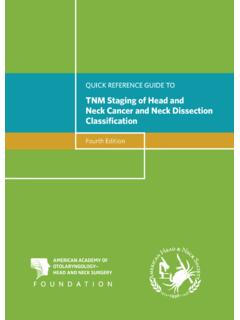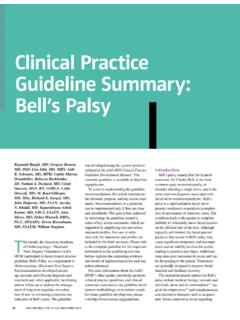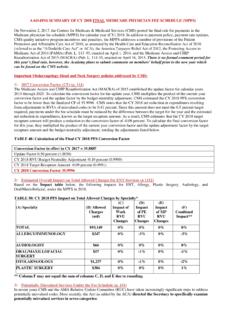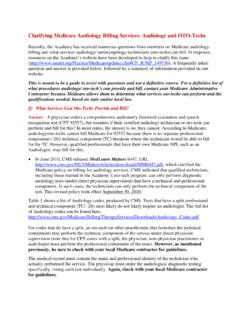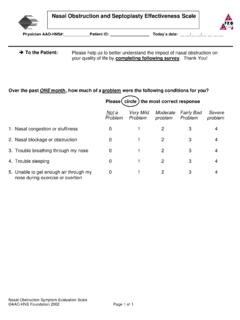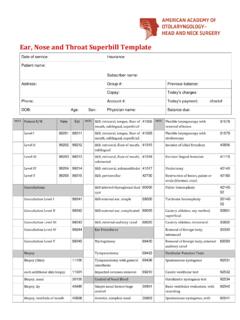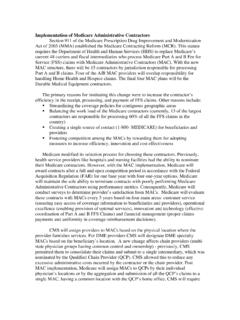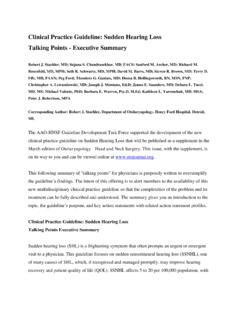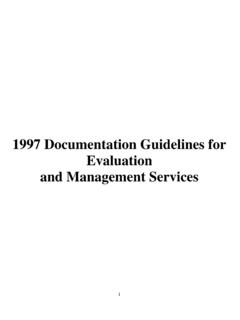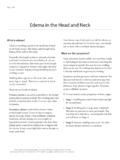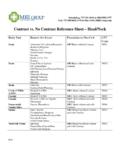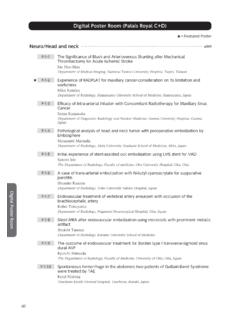Transcription of TNM Staging of Head and Neck Cancer and Neck …
1 QUICK REFERENCE GUIDE TO TNM Staging of Head and neck Cancer and neck dissection ClassificationFourth EditionSuggested citation: Deschler DG, Moore MG, Smith RV, eds. Quick Reference Guide to TNM Staging of Head and neck Cancer and neck dissection classification , 4th ed. Alexandria, VA: American Academy of Otolaryngology Head and neck surgery Foundation, 2014. 2014 All materials in this eBook are copyrighted by the American Academy of Otolaryngology Head and neck surgery Foundation, 1650 Diagonal Road, Alexandria, VA 22314-2857, and the American Head and neck Society, 11300 W. Olympic Blvd., Suite 600, Los Angeles CA 90064, and are strictly prohibited to be used for any purpose without prior written authorization from the American Academy of Otolaryngology Head and neck surgery Foundation and the American Head and neck Society. All rights more information, visit our website at , or Format: Fourth Edition, 2014 ISBN: 978-0-615-98874-0 Quick Reference Guide toTNM Staging of Head and neck Cancer and neck dissection ClassificationCopublished byAmerican Academy of Otolaryngology Head and neck surgery American Head and neck SocietyEdited by Daniel G.
2 Deschler, MD Michael G. Moore, MDRichard V. Smith, MDii TNM Staging of Head and neck Cancer and neck dissection ClassificationTable of Contents Preface ..iv Acknowledgments ..v I. Introduction ..2 A. Upper Aerodigestive Tract Sites ..2 Oral Cavity ..3 Oropharynx ..3 Hypopharynx ..4 Larynx ..4 Nasopharynx ..6 Nasal Cavity and Paranasal Sinuses ..7 B. Radiation Therapy and Chemotherapy ..7II. American Joint Committee on Cancer (AJCC) Tumor Staging by Site ..11 A. Oral Cavity ..11 B. Oropharynx ..12 C. Larynx ..12 D. E. Nasal Cavity and Paranasal F. Salivary Glands ..16 G. neck Staging under the TNM Staging System for Head and neck Tumors ..17 H. TNM Staging for the Larynx, Oropharynx, Hypopharynx, Oral Cavity, Salivary Glands, and Paranasal Sinuses .. iiiIII. AJCC Tumor Staging Nasopharynx, Thyroid, and Mucosal Melanoma.
3 19 A. Nasopharynx ..19 B. Thyroid ..20 C. Mucosal Melanoma ..23IV. Definition of Lymph Node Groups ..25 A. Levels IA and IB: Submental and Submandibular Groups ..25 B. Levels IIA and IIB: Upper Jugular Group ..26 C. Level III: Middle Jugular Group ..26 D. Level IV: Lower Jugular Group ..27 E. Levels VA and VB: Posterior Triangle Group ..28 F. Level VI: Anterior (Central) Compartment Group ..28V. Conceptual Guidelines for neck dissection classification ..29 A. Radical neck dissection ..29 B. Modified Radical neck dissection ..30 C. Selective neck dissection ..30 D. Extended Radical neck dissection ..34iv TNM Staging of Head and neck Cancer and neck dissection ClassificationPreface Staging is the language essential to the proper and successful management of head and neck Cancer patients. It is the core of diagnosis, treatment planning, application of therapeutics from multiple disciplines, recovery, follow-up, and scientific investigation.
4 Staging must be consistent, efficient, accurate, and reproducible. The head and neck Cancer caregiver can never be too fluent in this mode of communication, as we educate patients and navigate them toward cure. The simple clarification that Stage IV disease is not synonymous with a death sentence has powerful impact for patients and their families. With this imperative, the American Academy of Otolaryngology Head and neck surgery Foundation and the American Head and neck Society present the fourth edition of Quick Reference Guide to TNM Staging of Head and neck Cancer and neck dissection classification . Just as our knowledge of and therapeutics for head and neck Cancer evolve, so does the language we use in managing the disease. Such terms as chemo-radiation, organ preservation, HPV positive, and de-escalation are now central to care planning discussions. Likewise, the Staging system evolves to incorporate current knowledge and reflect state-of-the-art treatments.
5 This new edition of Quick Reference Guide to TNM Staging of Head and neck Cancer and neck dissection classification incorporates the changes from the seventh edition of the American Joint Commission on Cancer (AJCC) Cancer Staging Manual, as well as updated discussions of site-specific cancers. We hope this Quick Reference Guide will serve the practitioner and the patient equally well as we ready ourselves for further evolution of head and neck Cancer Staging and G. Deschler, MD Michael G. Moore, MD Richard V. Smith, MD Co-editor Co-editor vAcknowledgments The American Academy of Otolaryngology Head and neck surgery and the American Head and neck Society acknowledge the input from their Head and neck surgery Oncology Committee and Head and neck surgery Education Committees for the review of this publication. All Staging information in Chapters II and III are used with the permission of the American Joint Committee on Cancer (AJCC), Chicago, Illinois.
6 The original source for this material is the AJCC Cancer Staging Manual, Seventh Edition (2010), published by Springer Science and Business Media LLC, photos have been graciously donated by Richard V. Smith, 11II. American Joint Committee on Cancer (AJCC) Tumor Staging by SiteA. Oral CavityThe anterior border is the junction of the skin and vermilion border of the lip. The posterior border is formed by the junction of the hard and soft palates superiorly, the circumvallate papillae inferiorly, and the anterior tonsillar pillars laterally. The various sites within the oral cavity include the lip, gingival, hard palate, buccal mucosa, floor of mouth, anterior two-thirds of tongue, and retromolar TUMOR (T)TX Primary tumor cannot be assessedT0 No evidence of primary tumorTis Carcinoma in situT1 Tumor 2 cm or less in greatest dimensionT2 Tumor more than 2 cm but not greater than 4 cm in greatest dimensionT3 Tumor more than 4 cm in greatest dimensionT4a Moderately advanced local disease* Tumor invades through cortical bone, inferior alveolar nerve, floor of mouth, or skin of face that is, chin or nose (oral cavity).
7 Tumor invades adjacent structures ( , through cortical bone, into deep [extrinsic] muscle of tongue [genioglossus, hypoglossus, palataglos-sus, and styloglossus], maxillary sinus, skin of face)T4b Very advanced local disease Tumor invades masticator space, pterygoid plates, or skull base and/or encases internal carotid artery*Note: Superficial erosion alone of bone/tooth socket by gingival primary is not sufficient to classify as TNM Staging of Head and neck Cancer and neck dissection ClassificationB. OropharynxThe oropharynx includes the base of the tongue, the inferior surface of the soft palate and uvula, the anterior and posterior tonsillar pillars, the glossotonsillar sulci, the pharyngeal tonsils, and the lateral and posterior pharyngeal TUMOR (T)TX Primary tumor cannot be assessedT0 No evidence of primary tumorTis Carcinoma in situT1 Tumor 2 cm or less in greatest dimensionT2 Tumor more than 2 cm but not more than 4 cm in greatest dimensionT3 Tumor more than 4 cm in greatest dimension or extension to lingual surface of epiglottisT4a Moderately advanced local disease Tumor invades the larynx, deep/extrinsic muscle of the tongue, medial pterygoid, hard palate, or mandible*T4b Very advanced local disease Tumor invades the lateral pterygoid muscle, pterygoid plates, lateral nasopharynx, or skull base, or encases the carotid artery*Note.
8 Mucosal extension to lingual surface of epiglottis from primary tumors of the base of the tongue and vallecula does not constitute invasion of LarynxThe larynx includes all laryngeal structures from the tip of the epiglottis to the cricoid cartilage inferiorly and is subdivided into three specific sites: supraglottis, glottis, and of the LarynxSiteSubsiteSupraglottisSuprahyoid epiglottisInfrahyoid epiglottisAryepiglottic folds (laryngeal aspect)ArytenoidsVentricular bands (false vocal folds) 13 GlottisTrue vocal folds, including anterior and posterior commissures; occupies a horizontal place 1 cm in thickness, extending inferiorly from the lateral margin of the ventricleSubglottisRegion extending from the lower boundary of the glottis to the lower margin of the cricoid cartilagePRIMARY TUMOR (T)TX Primary tumor cannot be assessedT0 No evidence of primary tumorTis Carcinoma in situSupraglottisT1 Tumor limited to one subsite of the supraglottis with normal vocal fold mobilityT2 Tumor invades mucosa of more than one adjacent subsite of the supraglottis or glottis or region outside the supraglottis ( , mucosa of base of tongue, vallecula, medial wall of pyriform sinus) without fixation of the larynxT3 Tumor limited to the larynx with vocal fold fixation and/or invades any of the following.
9 Postcricoid area, pre-epiglottic tissues, paraglottic space, and/or inner cortex of thyroid cartilageT4a Moderately advanced local disease Tumor invades through the thyroid cartilage and/or invades tissues beyond the larynx ( , trachea, soft tissues of neck including deep extrinsic muscle of the tongue, strap muscles, thyroid, or esophagus)T4b Very advanced local disease Tumor invades prevertebral space, encases carotid artery, or invades mediastinal structuresGlottisT1 Tumor limited to the vocal fold(s) (may involve anterior or posterior commissure) with normal mobilityT1a Tumor limited to one vocal foldT1b Tumor involves both vocal foldsT2 Tumor extends to the supraglottis and/or subglottis, and/or with impaired vocal fold mobilityT3 Tumor limited to the larynx with vocal fold fixation and/or invasion of paraglottic space, and/or inner cortex of the thyroid cartilage T4a Moderately advanced local disease Tumor invades the outer cortex of the thyroid cartilage and/or invades 14 TNM Staging of Head and neck Cancer and neck dissection Classificationtissues beyond the larynx ( , trachea, soft tissues of the neck , including deep extrinsic muscle of the tongue, strap muscles, thyroid, or esophagus)T4b Very advanced local disease Tumor invades prevertebral space, encases carotid artery, or invades mediastinal structuresSubglottisT1 Tumor limited to the subglottisT2 Tumor extends to the vocal cord(s)
10 With normal or impaired Tumor imited to the larynx with vocal fold Moderately advanced local disease Tumor invades cricoid or thyroid cartilage and/or invades tissues beyond the larynx ( , trachea, soft tissues of the neck including deep extrinsic muscles of the tongue, strap muscles, thyroid, or esophagus)T4b Very advanced local disease Tumor invades prevertebral space, encases carotid artery, or invades mediastinal structuresD. HypopharynxThe hypopharynx includes the pyriform sinuses, the lateral and posterior hypopharyngeal walls, and the postcricoid TUMOR (T)TX Primary tumor cannot be assessedT0 No evidence of primary tumorTis Carcinoma in situT1 Tumor limited to one subsite of the hypopharynx and is 2 cm or less in greatest dimensionT2 Tumor invades more than one subsite of the hypopharynx or an adjacent site, or measures more than 2 cm but not more than 4 cm in greatest dimension without fixation of the hemilarynx or extension to the esophagusT3 Tumor more than 4 cm in greatest dimension or with fixation of the hemilarynx or extension to the esophagusT4a Moderately advanced local disease Tumor invades thyroid/cricoid cartilage, hyoid bone, thyroid gland, esophagus, or central compartment soft tissue* 15T4b Very advanced local disease Tumor invades prevertebral fascia, encases carotid artery, or involves mediastinal structures*Note.
